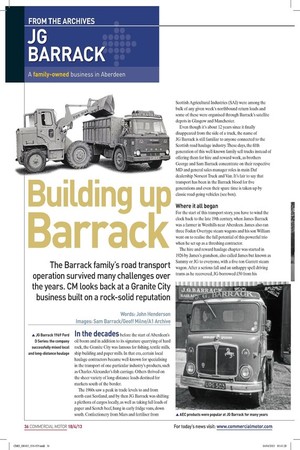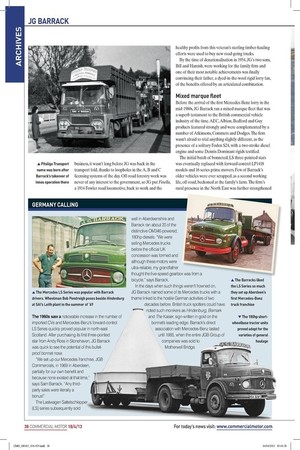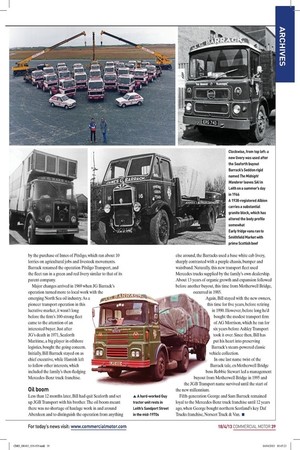BuiWing up Ba mac The Barrack family's road transport operation
Page 27

Page 28

Page 29

Page 30

If you've noticed an error in this article please click here to report it so we can fix it.
survived many challenges over the years. CM looks back at a Granite City business built on a rock-solid reputation V11411 LIZ; JOI II I Flel ILICI ZU11 Images: Sam Barrack/Geoff Milne/Al Archive In the decades before the start of Aberdeen's oil boom and in addition to its signature quarrying of hard rock, the Granite City was famous for fishing, textile mills, ship building and paper mills In that era, certain local haulage contractors became well-known for specialising in the transport of one particular industry's products, such as Charles Alexander's fish carriage. Others thrived on the sheer variety of long-distance loads destined for markets south of the border.
The 1960s saw a peak in trade levels to and from north-east Scotland, and by then JG Barrack was shifting a plethora of cargos locally, as well as taking full loads of paper and Scotch beef, hung in early fridge vans, down south. Confectionery from Mars and fertiliser from Scottish Agricultural Industries (SAT) were among the bulk of any given week's northbound return loads and some of these were organised through Ban-ack's satellite depots in Glasgow and Manchester.
Even though it's about 12 years since it finally disappeared from the side of a truck, the name of JG Barrack is still familiar to anyone connected to the Scottish road haulage industry. These days, the fifth generation of this well-known family sell trucks instead of offering them for hire and reward work, as brothers George and Sam Barrack concentrate on their respective MD and general sales manager roles in main Daf dealership Norscot Truck and Van. It's fair to say that transport has been in the Barrack blood for five generations and even their spare time is taken up by classic road-going vehicles (see box).
Where it all began For the start of this transport story, you have to wind the clock back to the late 19th century, when James Barrack was a farmer in Westhills near Aberdeen. James also ran three Foden Overtype steam wagons and his son William went on to realise the full potential of this powerful trio when he set up as a threshing contractor.
The hire and reward haulage chapter was started in 1926 by James's grandson, also called James but known as Sammy or JG to everyone, with a five-ton Garrett steam wagon. After a serious fall and an unhappy spell driving trams as he recovered, JG borrowed £50 from his wife-to-be and bought a petrol-engined Pierce Arrow. This motor brought a much welcomed return of Barrack's name to the Aberdeen transport industry and worked on agricultural, timber and road building jobs.
In the following years, the JG Barrack business expanded, thanks to some innovative methods of winning contracts and a sheer determination to do right by its customers.
Nationalisation The Second World War hit JG Ban-ack's progress head on when, overnight, the men from the ministry acquired six of his favourite Bedfords and an Albion without notice. After the war, it was business as usual, until the government's nationalisation programme in 1949 saw the 26-strong Barrack operation swallowed up by the lumbering giant that was BRS. JG had no intention of working for this organisation and used his compensation money to buy a filling station and garage in the Manorfield area of Aberdeen.
After watching the commercial traffic passing his business, it wasn't long before JG was back in the transport fold, thanks to loopholes in the A, B and C licensing systems of the day. Off-road forestry work was never of any interest to the government, so JG put Finella, a 1914 Fowler road locomotive, back to work and the healthy profits from this veteran's sterling timber-hauling efforts were used to buy new road-going trucks.
By the time of denationalisation in 1954, JG's two sons, Bill and Hamish, were working for the family firm and one of their most notable achievements was finally convincing their father, a dyed-in-the-wool rigid lorry fan, of the benefits offered by an articulated combination.
Mixed marque fleet Before the arrival of the first Mercedes-Benz lorry in the mid-1960s, JG Barrack ran a mixed marque fleet that was a superb testament to the British commercial vehicle industry of the time. AEC, Albion, Bedford and Guy products featured strongly and were complemented by a number of Atkinsons, Commers and Dodges. The firm wasn't afraid to trial anything slightly different, as the presence of a solitary Foden S24, with a two-stroke diesel engine and some Dennis Dominant rigids testified.
The initial batch of bonneted, LS three-pointed stars was eventually replaced with forward-control LP1418 models and 16 series prime movers. Few of Barrack's older vehicles were ever scrapped, as a second working life, off-road, beckoned at the family's farm. The firm's rural presence in the North East was further strengthened by the purchase of Innes of Pitsligo, which ran about 10 lorries on agricultural jobs and livestock movements. Barrack renamed the operation Pitsligo Transport, and the fleet ran in a green and red livery similar to that of its parent company.
Major changes arrived in 1969 when JG Barrack's operation turned more to local work with the emerging North Sea oil industry. As a pioneer transport operation in this lucrative market, it wasn't long before the firm's 100-strong fleet came to the attention of an interested buyer. Just after JG's death in 1971, Seaforth Maritime, a big player in offshore logistics, bought the going concern. Initially, Bill Barrack stayed on as chief executive, while Hamish left to follow other interests, which included the family's then-fledging Mercedes-Benz truck franchise.
Oil boom Less than 12 months later, Bill had quit Seaforth and set up JGB Transport with his brother. The oil boom meant there was no shortage of haulage work in and around Aberdeen and to distinguish the operation from anything else around, the Barracks used a base white cab livery, sharply contrasted with a purple chassis, bumper and waistband. Naturally, this new transport fleet used Mercedes trucks supplied by the family's own dealership. About 13 years of organic growth and expansion followed before another buyout, this time from Motherwell Bridge, occurred in 1985.
Again, Bill stayed with the new owners, this time for five years, before retiring in 1990. However, before long he'd bought the modest transport firm of AG Morrison, which he ran for six years before Ashley Transport took it over. Since then, Bill has put his heart into preserving Barrack's steam-powered classic vehicle collection.
In one last name twist of the Barrack tale, ex-Motherwell Bridge boss Robbie Stewart led a management buyout from Motherwell Bridge in 1995 and the JGB Transport name survived until the start of the new millennium.
Fifth-generation George and Sam Barrack remained loyal to the Mercedes-Benz truck franchise until 12 years ago, when George bought northern Scotland's key Daf Trucks franchise, Norscot Truck & Van. • In the early 20th century, Foden's five-ton Overtype steam wagon model played a key role in the Cheshire manufacturer becoming the world's largest builder of steamdriven road vehicles. The original James Barrack owned three of the highly flexible five-ton Overtypes and used them on a wide range of tasks on and off his farm.
FineIla, a 1914 Fowler road locomotive, was bought by JG in 1947 and the profits from its exploits in Highland timber extraction during the 1950s paid for many a diesel-engined lorry. At almost 100 years old, this nationally important Fowler remains in family ownership and in pristine condition. GERMANY CALLING The 1960s saw a noticeable increase in the number of imported CVs and Mercedes-Benz's forward-control LS Series quickly proved popular in north-east Scotland. After purchasing its first three-pointed star from Andy Ross in Stonehaven, JG Barrack was quick to see the potential of this bullet proof bonnet nose.
"We set up our Mercedes franchise, JGB Commercials, in 1969 in Aberdeen, partially for our own benefit and because none existed at that time," says Sam Barrack. "Any thirdparty sales were literally a bonus!"
The Lastwagen Sattelschlepper (LS) series subsequently sold well in Aberdeenshire and Barrack ran about 20 of the distinctive 0M346-powered, 180hp diesels. "We were selling Mercedes trucks before the official UK concession was formed and although these motors were ultra-reliable, my grandfather thought the five-speed gearbox was from a bicycle," says Barrack.
In the days when such things weren't frowned on, JG Barrack named some of its Mercedes trucks with a theme linked to the hostile German activities of two decades before. British truck spotters could have 1."—• noted such monikers as Hindenburg, Bismark and The Kaiser, sign-written in gold on the bonnet's leading edge. Barrack's direct \ association with Mercedes-Benz lasted until 1985, when the entire JGB Group of \ companies was sold to \ Motherwell Bridge.







































